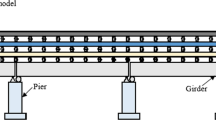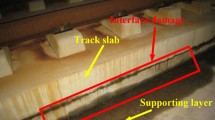Abstract
According to the structural damage characteristics of ballastless track of high-speed railway by investigation, a novel method for evaluating the influence of ballastless track of high-speed railway is presented. The dynamic model of ballastless track with damage property is established based on train-track spatial vibration system. The calculated and in situ tested results were compared to certify the model and computation program. Taking the track slab imperfections occurred in a tunnel along the real high-speed railway as an example, the influence of vibration responses of the train-track system with slab imperfections under different conditions is calculated and analyzed in comparison with normal slab. In addition, the maintenance effect on the repaired track structure is evaluated by considering the operate safety and comfort of high-speed train. It is concluded that large amplitude of slab arch imperfection results in higher acceleration of slab and car body. Therefore, train operation speed should be controlled in accordance with the safety standard such as wheel load reduction rate and derailment coefficient. In the case of low amplitude of slab arch imperfection, train operation speed should be controlled in accordance with the comfort standard such as Sperling index. The specific operation velocities were given correspondingly. Therefore, the mechanism and conclusions above can forecast intuitively in the field of track maintenance. The paper proposes a practical and valuable method for evaluating double-block ballastless track of high-speed railway.
















Similar content being viewed by others
References
Seungmin A (1994). Development of economic repair method for slab track. Report of the Railway General Research Institute, vol 11, pp 47–49 (in Japanese)
Bachmann H, Mohr W, Kowalski M (2003) The Rheda 2000 ballastless track system. Eur Railw Rev 8(1):44–51
Nurmikolu A (2012) Key aspects on the behavior of the ballast and substructure of a modern railway track: research-based practical observations in Finland. J Zhejiang Univ A 13(11):825–835
Poveda E, Yu RC, Lancha JC, Ruiz G (2015) A numerical study on the fatigue life design of concrete slabs for railway tracks. Eng Struct 100:455–467
Kaklauskas G (2004) Flexural layered deformational model of reinforced concrete members. Mag Concr Res 56(10):575–584
Sun L (2005) Study on several key problems in the design of double block ballastless track on the passenger dedicated lines. In: Proceedings of railway construction of passenger dedicated lines. Changjiang Press, Wuhan, pp 3–8 (in Chinese)
Zhu S, Cai C (2014) Interface damage and its effect on vibrations of slab track under temperature and vehicle dynamic loads. Int J Nonlinear Mech 58(1):222–232
Chen R, Xing J, Tian CX et al (2015) Effects of the interaction between beam and rail on slab warping on subgrade-bridge transition section. J Railw Eng Soc 11:37–42 (in Chinese)
Xu H, Lin HS, Wang P et al (2017) The influence of water immersion on the mechanical property of cement asphalt mortar and its implications on the slab track. J Vibroeng 19(1):477–486
Xiang J, He D, Zeng QY (2009) Effect of cement asphalt mortar disease on dynamic performance of slab track. J Cent South Univ (Sci Technol) 03:791–796 (in Chinese)
Xiang J, He D, Zeng QY (2008) Analysis theory of spatial vibration of high-speed train and slab track system. J Cent South Univ Technol 15(1):121–126
Xiang J, He D, Zeng QY (2003) Simulation of spatially coupling dynamic response of train-track time-variant system. J Cent South Univ Technol 10(3):226–230
Magheri S, Malvezzi M, Meli E et al (2011) An innovative wheel–rail contact model for multibody applications. Wear 271(1–2):462–471
Zeng QY, Lou P, Xiang J (2002) The principle of total potential energy with stationary value in elastic system dynamics and its application to the analysis of vibration and dynamic stability. J Huazhong Univ Sci Technol Urban Sci Ed 19(1):7–14
Zeng QY, Yang P (1986) The “set-in-right-position” rule for formulating dynamic system matrix and the finite element method of truss section for spatial analysis of truss girder. J China Railw Soc 8(2):48–59 (in Chinese)
Kalker JJ (1991) Wheel–rail rolling contact theory. Wear 144(4):243–261
Shabana AA, Zaazaa KE, Escalona JL, Sany JR (2004) Development of elastic force model for wheel/rail contact problems. J Sound Vib 269(1–2):295–325
Auciello Jury, Meli Enrico, Falomi Stefano, Malvezzi Monica (2009) Dynamic simulation of railway vehicles: wheel/rail contact analysis. Vehicle Syst Dyn 47(7):867–899
Pombo JC, Ambrósio JAC (2008) Application of a wheel–rail contact model to railway dynamics in small radius curved tracks. Multibody Syst Dyn 19(1–2):91–114
Falomi S, Malvezzi M, Meli E (2011) Multibody modeling of railway vehicles: innovative algorithms for the detection of wheel–rail contact points. Wear 271(1–2):453–461
Chung J, Hulbert GM (1993) A time integration algorithm for structural dynamics with improved numerical dissipation: the generalized-α method. J Appl Mech 60(2):371–375
Yu CY, Xiang J, Mao JH, Gong K et al (2016) Statistical analysis on field-test hunting wave of bogie frame for high-speed train. J Southeast Univ (Nat Sci Ed) 46(04):879–883 (in Chinese)
Yu CY, Xiang J, Chen T et al (2016) statistical analysis on ballastless track spectrum of high-speed railway. J Railw Sci Eng 13(9):1659–1665 (in Chinese)
China Academy of Railway Sciences (2013) Research on PSD of track irregularities of high-speed railway. China Academy of Railway Sciences, Beijing (in Chinese)
Han B, Cai XP, Zhao L et al (2013) Evaluation on dynamic performance of slab unwarp & gap of double -block ballastless track. Railw Eng 10:99–101 (in Chinese)
Li PG, Liu XY, Li GQ (2014) Influence of CA mortar void on dynamic characteristics of unit slab track on bridge. China Railw Sci 35(3):20–27 (in Chinese)
Xu H, Liu X, Xu JH et al (2013) Effect of cement asphalt mortar disease on dynamic performance of slab track. Railw Stand Des 57(9):9–12 (in Chinese)
The Ministry of Railway of PRC (2008) Testing of high-speed electic multiple unit on conpletion of construction (temp). Report (no. 28) of Chinese Ministry of railways, Beijing
Acknowledgements
Projects (U1261113) jointly supported by the National Natural Science Foundation Committed of China and Shenhua Group Corporation Limited; Project (20100162110022) supported by Special Fund for Doctor Programs in Institutions of Higher Learning of China; Project (TPL0901 and TPL1214) supported by the Open Program of the Traction Power State Key Laboratory; Project (GJJ151173, GJJ151175) supported by Jiangxi Science and Technology Foundation of Education Department.
Author information
Authors and Affiliations
Corresponding author
Additional information
Technical Editor: Kátia Lucchesi Cavalca Dedini.
Rights and permissions
About this article
Cite this article
Yu, C., Xiang, J., Mao, J. et al. Influence of slab arch imperfection of double-block ballastless track system on vibration response of high-speed train. J Braz. Soc. Mech. Sci. Eng. 40, 109 (2018). https://doi.org/10.1007/s40430-018-0972-4
Received:
Accepted:
Published:
DOI: https://doi.org/10.1007/s40430-018-0972-4




